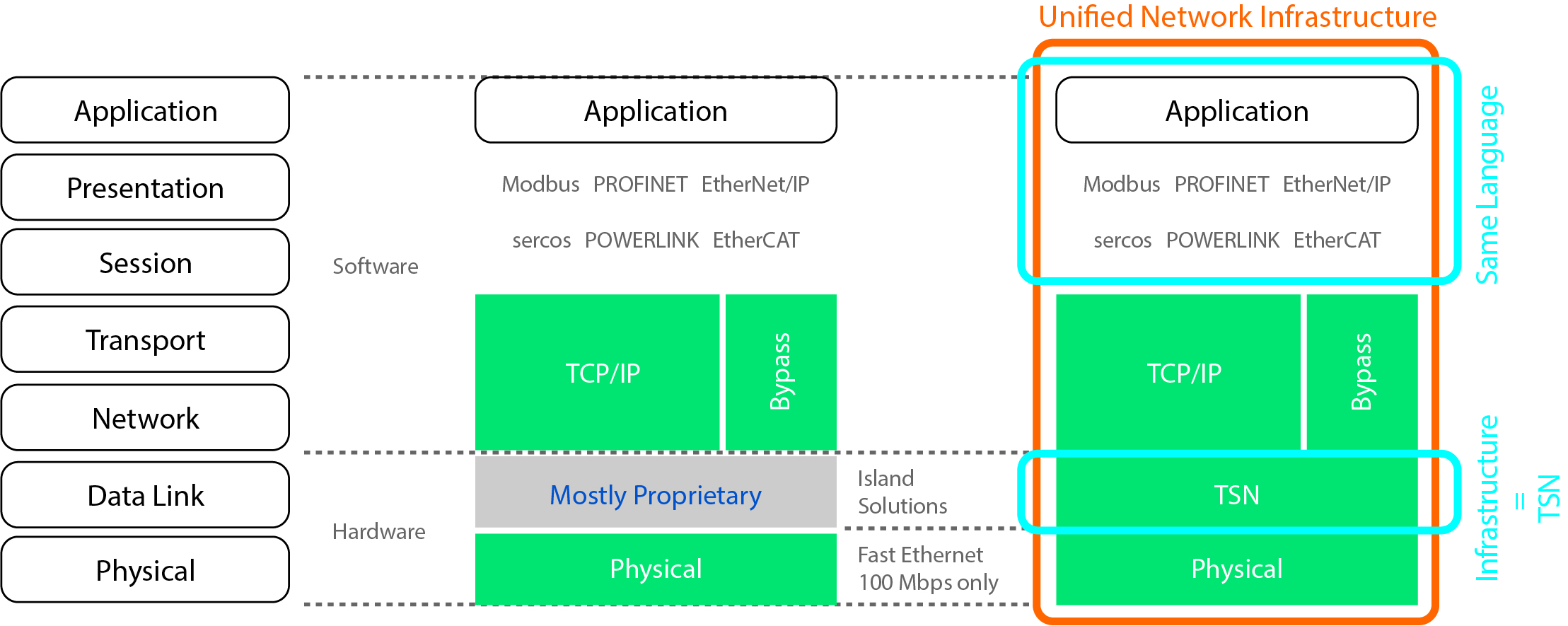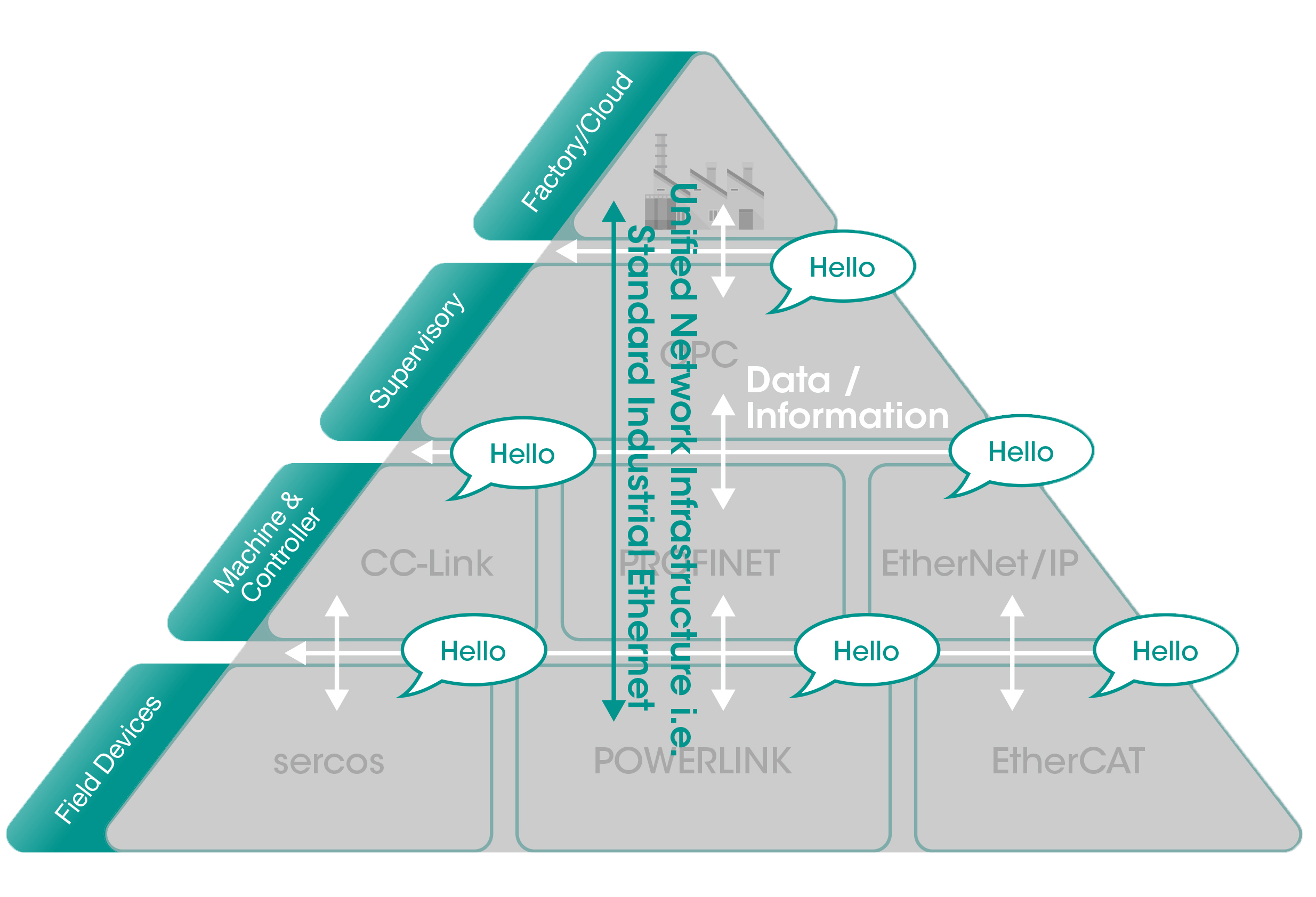Enabling INteroperablility to Ensure the Success of TSN in Industry 4.0
Time-sensitive networking (TSN) is essentially the next stage in the evolution of standard Ethernet technologies in order tto meet the
future requirements of the Industrial Internet of Things (IIoT). TSN enables standard Ethernet networks to provide deterministic services
and integrate individual automation sectors that were previously isolated by the numerous purpose-built protocols of the past.

Project Introduction
Time-sensitive networking (TSN) is essentially the next stage in the evolution of standard Ethernet technologies in order tto meet the
future requirements of the Industrial Internet of Things (IIoT). TSN enables standard Ethernet networks to provide deterministic services
and integrate individual automation sectors that were previously isolated by the numerous purpose-built protocols of the past.
Interoperability Is the Key to the Success of TSN
TSN technologies offer a scalable and predictable approach to deterministic networking over standard Ethernet. But since TSN is more
of a toolbox than a single comprehensive solution, system integrators must ultimately rely on independent vendors and multiple protocols
to meet the specific requirements of each industrial application. Thiss predicament is precisely why interoperability is the key to ensuring
the success of TSN adoption. Ultimatel,a unified infrastructure based on TSN fundamentally requires interoperability on two critical
fronts:

Common Architecture: Layer 2 Interoperability
As a deterministic Ethernet standard,TSN is essentially a Layer 2 technology within the Open Systems Interconnection (OSI) model of
computer networking. Also called the Data Link Layer, Layer 2 encompasses technologies that are programmed to forward Ethernet
frames. In other words, TSN is not a new technology, but it is all about the extenssion of IEEE 802.1-Ethernet. Ethernet can ensure the
data transmission in real time, but it cannot guarantee precisely when the data will arrive
In order to fullfil the Industry 4.0 requirements, which include deterministic communication over low-latency networks, robustness despite
high network loads, and converged data transport for both information technology (IT) and operation technology (OT), an IEEE working
group developed the open TSN standards.
With TSN-ready Ethernet switches, system integrators can fulfill the high-bandwidth real-time requirements of Industry 4.0 without
changing their existing application programs. Furthermore they can do all of this and even add "plug-and-produce" devices to converged
networks by simply using standard IEEE Ethernet Switches.
Common Semantics: Protocol interoperability Beyond Layer 2
Even though devices within the autonomous pyramid of the future can be developed by independent vendors, each piece of equipment
must be able to communicate with every other component in the system - not just layer 2 devices - in order to realize the full potentialof
the IIoT. Besides removing the barriers that isolate traditional islands of automation at the Layer 2 level, a successful TSN
implementation requires protocl interoperability across layers to enable more flexible topologies and open up new oppertunitites for
industrial applications
For example, industry organizations around the world - includingthe CC-Link Partner Association (CLPA), EtherCAT Technology Group
(ETG), Ethernet Powerlink Standarization Group (EPSG), Mechanical Engineering Industry Association (VDMA), Open DeiceNet
Vendors Association (ODVA) and PROFIBUS & PROFINET International (PI), and more -are coalescing aroung the OPC Unified
Architecture (OPC UA) and companion specs for achieving common smenatics among different vendors and standards

The Unified Foundation of Industrial Networking
As the IIoT requires high-bandwidth, low-latency, deterministic networking to enable real-time communictaions for industrial control
systems, TSN brings standard Ethernet technologies that can provide deterministic services, evolving beyond their traditional limitations
of best.effort communications. manufacturers no longer need to confine their applications to isolated islands of automation and control
systems, Instead, industrial applications can look forward to an intefrated future with new bilateral communication flows that transcend
the horizontal and vertical compartmentss of the traditional Purdue Model
As international stanndards organizations and device vendors like Moxa continue to coalesce around TSN, it is obvious that this standard
Ethernet technologies will become the future foundation of industrial networking
Time-sensitive networking (TSN) is essentially the next stage in the evolution of standard Ethernet technologies in order tto meet the
future requirements of the Industrial Internet of Things (IIoT). TSN enables standard Ethernet networks to provide deterministic services
and integrate individual automation sectors that were previously isolated by the numerous purpose-built protocols of the past.
Interoperability Is the Key to the Success of TSN
TSN technologies offer a scalable and predictable approach to deterministic networking over standard Ethernet. But since TSN is more
of a toolbox than a single comprehensive solution, system integrators must ultimately rely on independent vendors and multiple protocols
to meet the specific requirements of each industrial application. Thiss predicament is precisely why interoperability is the key to ensuring
the success of TSN adoption. Ultimatel,a unified infrastructure based on TSN fundamentally requires interoperability on two critical
fronts:
- Common architecture that is TSN compliant for Layer 2 networking and messaging
- Common semantics for communitcation across multiple protocols

Common Architecture: Layer 2 Interoperability
As a deterministic Ethernet standard,TSN is essentially a Layer 2 technology within the Open Systems Interconnection (OSI) model of
computer networking. Also called the Data Link Layer, Layer 2 encompasses technologies that are programmed to forward Ethernet
frames. In other words, TSN is not a new technology, but it is all about the extenssion of IEEE 802.1-Ethernet. Ethernet can ensure the
data transmission in real time, but it cannot guarantee precisely when the data will arrive
In order to fullfil the Industry 4.0 requirements, which include deterministic communication over low-latency networks, robustness despite
high network loads, and converged data transport for both information technology (IT) and operation technology (OT), an IEEE working
group developed the open TSN standards.
With TSN-ready Ethernet switches, system integrators can fulfill the high-bandwidth real-time requirements of Industry 4.0 without
changing their existing application programs. Furthermore they can do all of this and even add "plug-and-produce" devices to converged
networks by simply using standard IEEE Ethernet Switches.
Common Semantics: Protocol interoperability Beyond Layer 2
Even though devices within the autonomous pyramid of the future can be developed by independent vendors, each piece of equipment
must be able to communicate with every other component in the system - not just layer 2 devices - in order to realize the full potentialof
the IIoT. Besides removing the barriers that isolate traditional islands of automation at the Layer 2 level, a successful TSN
implementation requires protocl interoperability across layers to enable more flexible topologies and open up new oppertunitites for
industrial applications
For example, industry organizations around the world - includingthe CC-Link Partner Association (CLPA), EtherCAT Technology Group
(ETG), Ethernet Powerlink Standarization Group (EPSG), Mechanical Engineering Industry Association (VDMA), Open DeiceNet
Vendors Association (ODVA) and PROFIBUS & PROFINET International (PI), and more -are coalescing aroung the OPC Unified
Architecture (OPC UA) and companion specs for achieving common smenatics among different vendors and standards

The Unified Foundation of Industrial Networking
As the IIoT requires high-bandwidth, low-latency, deterministic networking to enable real-time communictaions for industrial control
systems, TSN brings standard Ethernet technologies that can provide deterministic services, evolving beyond their traditional limitations
of best.effort communications. manufacturers no longer need to confine their applications to isolated islands of automation and control
systems, Instead, industrial applications can look forward to an intefrated future with new bilateral communication flows that transcend
the horizontal and vertical compartmentss of the traditional Purdue Model
As international stanndards organizations and device vendors like Moxa continue to coalesce around TSN, it is obvious that this standard
Ethernet technologies will become the future foundation of industrial networking












